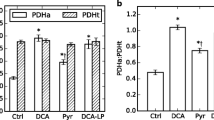Abstract
This work was designed to test whether phosphofructokinase is a target for emetine action on the heart. The effects of 37, μM emetine on the activities of phosphofructokinase and hexokinase were measured in homogenates from perfused hearts. The action of increasing concentrations of emetine was determined in nonperfused heart homogenates. The effect of 37 μM emetine or control solutions on the concentration of fructose-6-phosphate and fructose-1,6-phosphate was measured. The effect of 37 μM emetine or control perfusion on the utilization of fructose-6-phosphate by phosphofructokinase in centrifugation supernatants of homogenates and in reconstituted 27,000g pellets was measured. Double-reciprocal plots of fructose-6-phosphate concentrations vs phosphofructokinase activities were plotted. Emetine decreased phosphofructokinase activity in homogenates from both perfused and nonperfused hearts. Emetine did not inhibit cardiac hexokinase activity. In homogenates from nonperfused hearts, the maximal inhibition with high concentrations of emetine was approx 50%. Emetine perfusion caused a simultaneous increase in the phosphofructokinase substrate fructose-6-phosphate and a decrease in the phosphofructokinase product fructose-1,6-bisphosphate. Phosphofructokinase and, consequently, glycolytic flux appear to be subcellular targets for emetine in the heart. Homogenate centrifugation studies indicate that emetine acts on bound rather than unbound phosphofructokinase. The inhibition may be uncompetitive in nature.
Similar content being viewed by others
References
Pan, S.J. and Combs, A.B. (1995). Emetine-induced lactate dehydrogenase release, functional changes, and electrocardiographic changes in the rat heart in vivo. Toxicol. In Vitro 9:219–229.
Pan, S.J. and Combs, A.B. (1995). Effects of pharmacological interventions on emetine cardiotoxicity. Toxicology 97:93–104.
Parker, J.C. and Hoffman, J.F. (1967). The role of membrane phosphoglycerate kinase in the control of glycolytic rate by active cation transport in human red blood cells. J. Gen. Physiol. 50:893–916.
Paul, R.J. (1983). Functional compartmentalization of oxidative and glycolytic metabolism in vascular smooth muscle. Am. J. Physiol. 244:C399-C409.
Macleod, D.P. and Daniel, E.E. (1965). Influence of glucose on the transmembrane action potential of anoxic papillary muscle. J. Gen. Physiol. 48:887–899.
Hasin, Y. and Barry, W.H. (1984). Myocardial metabolic inhibition and membrane potential, contraction, and potassium uptake. Am. J. Physiol. 247:H322-H329.
Weiss, J. and Hiltbrand, B. (1985). Functional compartmentation of glycolytic versus oxidative metabolism in isolated rabbit heart. J. Clin. Invest. 75:436–447.
Wilkinson, J.H. and Robinson, J.M. (1974). Effect of ATP on release of intracellular enzymes from damaged cells. Nature 249:662–663.
Higgins, T.J.C., Allsopp, D., Bailey, P.J., and D’Souza, E.D.A. (1981). The relationship between glycolysis, fatty acid metabolism and membrane integrity in neonatal myocytes. J. Mol. Cell. Cardiol. 13:599–615.
Gebhard, M.M., Denkhaus, H., Sakai, K., and Spieckermann, P.G. (1977). Energy metabolism and enzyme release. J. Mol. Med. 2:271–283.
Bricknell, O.L., Daries, P.S., and Opie, L.H. (1981). A relationship between adenosine triphosphate, glycolysis and ischemic contracture in the isolated rat heart. J. Mol. Cell. Cardiol. 13:941–945.
Higgins, T.J. and Bailey, P.J. (1983). The effects of cyanide and iodoacetate intoxication and ischaemia on enzyme release from the perfused rat heart. Biochim. Biophys. Acta 762:67–75.
Kehrer, J.P., Park, Y., and Sies, H. (1988). Energy dependence of enzyme release from hypoxic isolated perfused rat heart tissue. Am. J. Physiol. 88:1855–1860.
Bergmeyer, H.U., Grassl, M., and Walter, H.E. (1983). Reagents for enzymatic analysis: Enzymes, in Methods of Enzymatic Analysis, 3rd ed., vol. 2 (Bergmeyer, H.U., ed.), Verlag Chemie, Deerfield Beach, Florida, pp. 185–223.
Mansour, T.E. (1963). Studies on heart phosphofructokinase: purification, inhibition, and activation. J. Biol. Chem. 238:2285–2292.
Michal, G. (1983). Metabolites 1: Carbohydrates, in Methods of Enzymatic Analysis, 3rd ed., vol. 6 (Bergmeyer, H.U., Bergmeyer, J., and Grabl, M., eds.), Verlag Chemie, Deerfield Beach, FL, pp. 191–198, 342–350.
Lilling, G. and Beitner, R. (1990). Decrease in cytoskeleton-bound phosphofructokinase in muscle induced by high intracellular calcium, serotonin and phospholipase A2 in vivo. Int. Biochem. 22:857–863.
Anderson, R.L., hanson, T.E., and Sapico, V.L. (1975). D-Fructose-1-phosphate kinase, in Methods in Enzymology: Vol. 42. Carbohydrate Metabolism, Part C (Wood, W.A., ed.), Academic Press, New York, pp. 63–66.
Mansour, T.E. (1966). Phosphofructokinase: II. Heart muscle, in Methods in Enzymology: Vol. 9. Carbohydrate metabolism (Wood, W.A., ed.), Academic Press, New York, pp. 430–436.
Gudbjarnason, S., Mathes, P., and Ravens, K.G. (1970). Functional compartmentation of ATP and creatine phosphate in heart muscle. J. Mol. Cell. Cardiol. 1:325–339.
Lopaschuk, G.D., Wambolt, R.B., and Barr, R.L. (1992). An imbalance between glycolysis and glucose oxidation is a possible explanation for the detrimental effects of high levels of fatty acids during aerobic reperfusion of ischemic hearts. J. Pharmacol. Exp. Ther. 264:135–144.
Jeremy, R.W., Ambrosio, G., Pike, M.M., Jacobus, W.E., and Becker, L.C. (1993). The functional recovery of postischemic myocardium requires glycolysis during early reperfusion. J. Mol. Cell. Cardiol. 25:261–276.
Hofer, W.H. (1985). Phosphorylation of phosphofructokinase: the possible role of covalent modification in the regulation of glycolysis, in Regulation of Carbohydrate Metabolism, vol. 2 (Beitner, R., ed.), CRC Press, Boca Raton, FL, pp. 107–139.
Chen-Zion, M., Lilling, G., and Beitner, R. (1993). The dual effects of Ca++ on binding of the glycolytic enzymes, phosphofructokinase and aldolase, to muscle cytoskeleton. Biochem. Med. Metab. Biol. 49:173–181.
Clarke, F., Stephan, P., Morton, D., and Weidemann, J. (1985). Glycolytic enzyme organization via the cytoskeleton and its role in metabolic regulation, in Regulation of Carbohydrate Metabolism, vol. 2 (Beitner, R., ed.), CRC Press, Boca Raton, FL, pp. 1–31.
Author information
Authors and Affiliations
Corresponding author
Rights and permissions
About this article
Cite this article
Pan, S.J., Combs, A.B. Emetine inhibits glycolysis in isolated, perfused rat hearts. Cardiovasc Toxicol 3, 311–318 (2003). https://doi.org/10.1385/CT:3:4:311
Received:
Revised:
Accepted:
Issue Date:
DOI: https://doi.org/10.1385/CT:3:4:311




